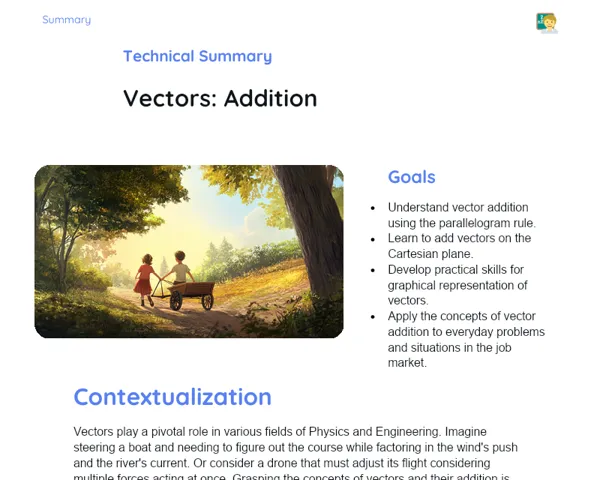Socioemotional Summary Conclusion
Goals
1. 🌟 Distinguish between conductors and insulators by exploring their key properties.
2. 🧪 Experimentally determine whether a material acts as a conductor or an insulator.
3. 🌍 Relate the concepts to everyday scenarios you experience daily.
4. 💡 Enhance socio-emotional skills like self-awareness, self-control, and effective communication during the lesson.
Contextualization
Did you know that electricity is part and parcel of our daily lives? Whether it’s switching on a light or charging your mobile, we constantly interact with materials that either conduct or insulate electric current. Understanding how these materials work is not only intriguing but also vital for making safe, informed decisions. Similarly, just as we need the right materials for electrical safety, we must also learn to regulate our emotions to interact better with others. 🚀✨
Exercising Your Knowledge
Conductors
Conductors are materials that allow electric current to pass through them with ease. They have free electrons that move around freely, making the flow of electricity possible. Knowing how conductors work is important not only for our understanding of electricity but also when selecting materials for wiring and practical applications in daily life.
-
Free Electrons: In conductors, electrons are loosely attached, allowing them to move freely and carry current.
-
Common Examples: Metals like copper, aluminium, and even gold are excellent conductors and are commonly used in electrical wiring and circuits.
-
Everyday Use: In our homes, electrical wires are typically made of copper due to its excellent conducting properties, and are coated with plastic (an insulator) for safety.
Insulators
Insulators are materials that restrict the flow of electric current. Their electrons are tightly bound to the atoms, preventing free movement. A good understanding of insulators is crucial for ensuring safety in electrical installations and avoiding hazards.
-
Strongly Bound Electrons: In insulators, electrons cling tightly to their atoms which prevents the easy flow of electricity.
-
Common Examples: Materials such as glass, rubber, and plastic are typical insulators, used widely in electrical devices to prevent unwanted current leakage.
-
Safety: Insulators are critical in tools and appliances to protect users from electric shocks, thereby promoting safety in everyday electrical use.
Electrical Circuits
Electrical circuits are complete paths through which electric current flows. They consist of a power source, conductors, insulators, and devices that use energy, like bulbs. Learning to build and understand circuits not only applies the concepts of conductors and insulators but also helps develop practical skills and problem-solving abilities.
-
Basic Components: A simple circuit includes a battery (power source), wires (conductors), and a device such as a light bulb.
-
Assembly: Learning how to put together and test circuits helps you see firsthand how electricity flows through various materials, reinforcing practical knowledge.
-
Practical Application: Understanding circuits finds use in multiple fields like electronics, engineering, and technology, which is important for many career paths.
Key Terms
-
Conductors: Materials that let electric current pass through easily due to the presence of free electrons.
-
Insulators: Materials that restrict electric current flow because their electrons are tightly bound.
-
Free Electrons: Electrons that are not firmly attached to atoms, which allows for easier conduction of electricity in conductors.
-
Electric Current: The flow of electrons, usually guided through a conductor by a difference in electrical potential (voltage).
-
Electrical Circuit: A closed loop through which electrical current flows, including a power source, conductors, and devices.
For Reflection
-
Recall a situation during a group activity when you felt overwhelmed. How did you manage those emotions, and what impact did it have on teamwork?
-
How can understanding conductors and insulators contribute to making our daily life safer? Can you give any practical examples?
-
Reflect on why being aware of and managing your emotions is important in a learning environment. How might this influence both your academic work and your relationships with peers?
Important Conclusions
-
🔑 Conductors are materials that enable the easy flow of electric current due to their free electrons.
-
🚫 Insulators are materials that inhibit electric current flow, as their electrons are bound tightly to their atoms.
-
💡 A clear grasp of conductors and insulators is essential for ensuring both safety and efficiency in handling electricity.
-
🌱 Incorporating socio-emotional skills, like managing emotions and effective teamwork, is key to creating a supportive and productive learning environment.
Impacts on Society
Electricity is indispensable in our modern routines—be it our smartphones or home appliances. Every device depends on a smart combination of conductors and insulators. Knowing how these materials work not only promotes safer practices but also encourages us to utilise technology with prudence. Moreover, learning to manage our emotions equips us to handle both academic and personal challenges more effectively, paving the way for a harmonious and productive environment. In a world where electricity underpins technological progress, understanding these principles could be a stepping stone to innovations in fields like electrical engineering, product design, and materials science. Simultaneously, nurturing emotional intelligence can foster better collaboration and mutual respect in every sphere of our lives.
Dealing with Emotions
Let’s bring emotional regulation into our daily routine! First, take a moment at home to note down the emotions you experienced during the class – both positive and negative. Reflect on what triggered these feelings and what outcomes they led to. Identify and name these emotions accurately, and think over the best ways to express them. Finally, consider strategies – maybe practising deep breathing or taking short breaks – to better manage these feelings in the future. This process will not only deepen your understanding of conductors and insulators but also help you handle emotions more effectively. 🌟
Study Tips
-
📝 Develop mind maps to visually contrast conductors and insulators, including practical examples from everyday life.
-
📚 Make use of online resources such as videos and simulators to see electrical circuits in action.
-
🤝 Engage in group study sessions and discuss your learnings with peers; this approach reinforces knowledge and hones social skills.


